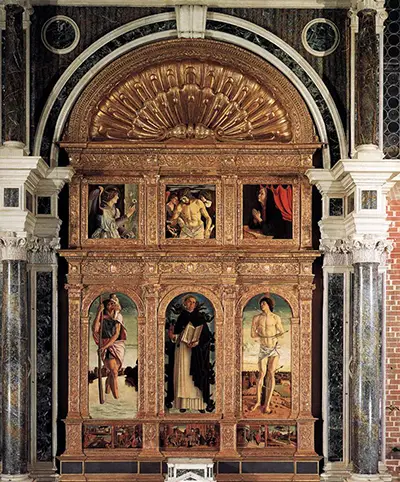The Saint Vincent Ferrer altarpiece was painted by Giovanni Bellini. It is thought to have been completed in 1464 in accordance with an associated receipt.
The painting is tempera on panel and is still in its original position at the Santi Giovanni e Paolo in Venice. It is thought that the piece was originally commissioned by the Church itself to celebrate the miracles of Saint Ferrer, who had only recently been canonized. However, it is still not actually known for sure if this is true.
Panel paintings such as the Saint Vincent Ferrer piece became fashionable in Italy during the 1300’s and were painted as a series of different paintings rather than just one. This alter piece illustrates saint Christopher, saint Vincenzo Frazer and saint Sebastian at the centre. The top sequence is a Pieta, the archangel Gabriel and the Virgin Mary. There was also originally a lunette of God the father, but this part has since been lost.
It is thought that the parts of the altar piece were completed seperately, as the techniques used are somewhat different among the paintings. It is assumed either that the artist did the work at different times, or that some of the work was undertaken by a different artist. The answer to this is unknown. The piece is a polyptych, made up of several different paintings.
The methods used for this masterpiece were common at the time, known as Tempera on panel. The tempera method involved the mixing of paint with a water soluble medium, commonly glutinous materials such as egg yolk. The paint dried rapidly and therefore could be applied in thin layers, which in turn allowed for precision over a relatively small amount of time.
The paint provides a smooth, matt finish which lasts for hundreds of years without damage from light. Painting was usually applied to either gesso or wood during this time, as it allowed the thin layers of the paint to adhere effectively to the substrate. This method of painting was used in Italy prior to c 1500, at which time oil paint became the preferred medium used by artists.




